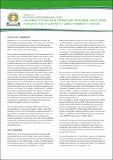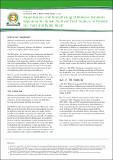Browsing Strategies/ Policy Frameworks by Subject "Aflatoxin"
Now showing items 1-15 of 15
-
Aflatoxin: A threat to competitiveness of EAC Agricultural produce and products in domestic and international markets.
(EAC, 2018-04)The EAC Partner States are losing trade and general market accessibility due to sale of aflatoxin contaminated foods. Aflatoxins are barriers to trade, notwithstanding the health implications to the consumer upon sustained ... -
Controlling the burden of liver disease through integration Hepatitis A and B vaccination into National Immunization programs of the EAC Partner States.
(EAC, 2018-04)Liver cancer is the leading cause of deaths in world. Chronic hepatitis B causes 80% of liver cancer causes in the EAC region. The combination of Aflatoxin exposure with hepatitis infection especially among people, who are ... -
Disposal and alternative use of Aflatoxin contaminated food.
(EAC, 2018-04)Agricultural commodities, including maize, groundnuts, and cassava, milk, and cotton seed contaminated with aflatoxin pose serious threat to human and animal health, and to the economies of the EAC Partner States. It is, ... -
Guidelines for evaluating and reporting the efficacy of pest control products for plants
(EAC, 2019)These procedures are developed pursuant to article 108(e) of the Treaty for the establishment of the EAC (Treaty for the establishment of the East African Community, 1999). The procedure outlined below shall be employed ... -
Guidelines for the conduct of supervised pesticide residue field trials on crops
(EAC, 2019)These guidelines have been developed for trial managers, researchers and pesticide manufacturers to provide residue data to support Pesticide registration and setting both Codex and regional Maximum Residue Limits (MRL) ... -
Guidelines on Data Requirements for the Registration of Conventional Chemical Pesticides Used in Agriculture and Forestry in EAC Partner States
(EAC, 2019)The present guidelines are an update of the Agriculture (Farm Input) Forms published by the East African Community in January 2005. These forms have been used by EAC Partner States as a basis for national data requirements ... -
Harmful effects of Aflatoxin and its impact on Human Health
(EAC, 2018-04)The EAC region experiences high temperature and humidity which favors growth of Aflatoxin producing fungi normally found in the soil. Contamination of food crops and food products occurs in all stages of food value chain ... -
Harmonization and strengthening of Aflatoxin Standards regulation for human food and food products to promote public health
(EAC, 2018-04)Aflatoxin contamination in food is a public health concern. East African Community estimates of Aflatoxin contamination in food are as high as 60% in some regions. -
Impact of Aflatoxin exposure to children during the first 1000 days of life.
(EAC, 2018-04)The most vulnerable group of population is exposed to Aflatoxin within the 1000 days of life from conception to child's second birthday. This population group is highly affected because their body systems have not fully ... -
Mitigating harmful effects of Aflatoxin on animal health and productivity.
(EAC, 2018-04)Livestock plays a key role in the economies and livelihoods of the people in the East African Community (EAC). The sector contributes an average of 10% of GDP of EAC partner states. Average contribution of livestock to ... -
Prevention and Control of Aflatoxin and associated losses during post harvest handling of agricultural commodities in EAC.
(EAC, 2018-04)Aflatoxins are a set of poisonous substances produced by fungi (molds) that can potentially cause cancer and contribute to stunting and immunosuppression in vulnerable groups. Aflatoxin contamination occurs in major staple ... -
Technical Criteria for designating efficacy trial Centers –East African Community (EAC)
(EAC, 2019)This document prescribes the technical requirements for private or public institutions for designation as Efficacy Trial Centers for conducting efficacy studies that support or are intended to support applications for ... -
Use of Biocontrol for Aflatoxin Prevention and Control in the EAC
(EAC, 2018-04)The main cause of high level of contamination includes limited use of Good Agricultural Practices (GAPs) such as use of drought and insect resistant varieties, the application of inputs to ensure plant health, the timely ...















